Multiple Choice
Identify the
choice that best completes the statement or answers the question.
|
|
|
MAD 1960 - 1972
With Cold War tensions heightening at the start of
the 1960s, the superpowers are drawn into an escalating arms race. The world's safety depends on
a nuclear paradox known as "mutual assured destruction."
ON ALERT
During the Cold War, the armed forces of both the United
States and U.S.S.R. were in a state of constant vigilance. War, if it came, would soon go
"nuclear." Ballistic Missile Early Warning System radars were in operation in Alaska,
Greenland and England. America, still remembering the surprise attack at Pearl Harbor, did not want
to be surprised again.
In 1961, John F. Kennedy became the new American president. He inherited
the doctrine of "massive retaliation" to any Soviet attack. Massive retaliation had been
conceived at a time of clear U.S. nuclear superiority. But now, the Russians were trying to catch up.
| | | |
|
|
|
1.
|
What does Mutual Assured
Destruction mean
a. | The country that stats the war will
be destroyed | c. | The country that
is attacked will be destroyed | b. | Both countries who go to war are guaranteed to be
destroyed | d. | Both countries agree that neither
will be destroyed in a war |
|
|
|
2.
|
What is a “nuclear
paradox?”
a. | War is good for all countries who
engage in it | c. | Only nuclear war
can save a nation from destruction | b. | The paradox bomb is the most powerful bomb in the
world | d. | You go to war to save your country but your country is
guaranteed to be destroyed |
|
|
|
3.
|
In the early 60’s the
U.S. had hundreds of missiles and airplanes with nuclear warheads pointed at the Soviet Union. In
case of war the Soviets were warned that all of their cities and most of their military would be
destroyed. What was this policy called?
a. | Massive
retaliation | c. | The No Win
Policy | b. | One city at a time | d. | The No Loss Policy |
|
|
|
BUILDUP
Soviet leader Nikita Khrushchev wanted to remind the West
of his nation's power. On October 30, 1961, he broke a moratorium (agreement not to test) on
nuclear testing. A Russian bomber dropped the largest bomb the world had ever seen. Its explosion was
the equivalent of more than 50 million tons of TNT, more than all the explosives used in World War
II. It was so powerful that people 50 miles from ground zero were blown off their feet.
President
Kennedy, angered by the new Soviet tests, announced that the United States would proceed in its
development of nuclear weapons. But public opinion in the West was turning against the nuclear arms
buildup. In Europe, the Campaign for Nuclear Disarmament and other "ban the bomb" groups
began to emerge. Kennedy and his defense secretary, Robert McNamara, meanwhile, were having second
thoughts about the strategy of massive retaliation -- now it meant the United States would be
initiating the use of nuclear weapons against an equally equipped Soviet Union.
| 
McNamara presented U.S. military planners with an appealing alternative: No
Cities/Counterforce. Soviet cities were no longer to be targeted, only Soviet military forces. But
the new strategy was dismissed by the Soviets as self-deluding. | | |
|
|
|
4.
|
Why did Khrushchev detonate the
massive hydrogen bomb in October 1961
a. | He wanted to impress the West with
Soviet power | c. | The Soviets were
trying to get rid of old weapons. | b. | The U.S. and the Soviets had an agreement that they could test whenever they
wanted | d. | He wanted to warn the Soviet people to remain loyal to
communism |
|
|
|
5.
|
Groups who were opposed to the
use of nuclear weapons in war were called
a. | military support
groups | c. | conservatives | b. | ban the bomb groups | d. | nuke-em groups |
|
|
|
6.
|
The Soviets thought that the
Kennedy administration idea that we should not target each other cities any longer was
a. | unrealistic | c. | something they were already doing | b. | a good idea | d. | hateful |
|
|
|
CLOSE CALL
In October 1962, the Cuban Missile Crisis brought the
world to the brink of nuclear war. For nearly two weeks, Moscow and Washington were involved in a
tense contest of wills over the presence of Soviet missiles in Cuba. Khrushchev, confronted by
Kennedy's nuclear superiority, backed down -- ending the crisis. But both sides were shocked at
how close they had come to nuclear war. They set up a "hot line," a direct communications
link between the Soviet and U.S. capitals.
Several months later, the Soviet Union, United States
and Britain agreed to a Limited Test Ban Treaty, ending atmospheric tests. Nuclear testing would
continue, but underground. The race to increase stockpiles continued as well, as the Kremlin --
smarting from the Cuban crisis -- vowed never again to confront America from a position of weakness.
A grim logic was beginning to emerge. Nuclear disarmament was not achievable, yet nuclear war was
unthinkable. The White House became convinced that the strategy of MAD, mutual assured destruction,
was the only deterrent to nuclear conflict |
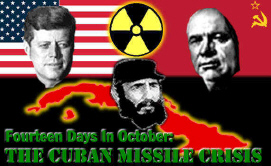
War?
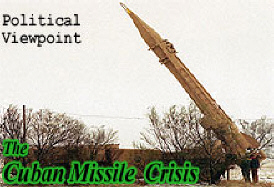 | | |
|
|
|
7.
|
How did the Soviets react to
the Cuban Missile Crisis?
a. | They cut back on the development of
more powerful bombs | c. | Proposed a ban on
nuclear weapons | b. | They built up their nuclear forces to become more of a nuclear
threat | d. | Destroyed all of their nuclear
weapons. |
|
|
|
8.
|
What did the U.S., Britain and
the Soviets do to ban atmospheric testing?
a. | Agreed to limit bombs to those
already in their stockpiles | c. | Agreed to test bombs underground | b. | Agreed to test only in the upper
atmosphere | d. | Agreed not to test any more
bombs |
|
|
|
9.
|
What was the purpose of
“the hotline?”
a. | To prevent accidental nuclear
war | c. | To warn the U.S. and the Soviets
that each were going to attack | b. | To warn the Soviets that we were going to
attack | d. | Allow government officials time to go to bunkers in case
of an attack |
|
|
|
10.
|
What was the “grim
logic” that emerged from the Cuban Missile Crisis?
a. | Neither the Soviets or the West
could disarm even though war was too horrible to think about | c. | The Cuban Missile Crisis was a logical
affair | b. | The Soviets and the West could not disarm for 100
years | d. | The Cuban Missile Crisis proved that safeguards against
war were in place and working well. |
|
|
|
11.
|
The MAD strategy
was
a. | a guarantee of
war | c. | developed in the Kennedy
administration | b. | a way to prevent war | d. | a comic book approach to world
affairs |
|
|
|
DETERRENCE
For MAD to succeed, each side needed to be able to
retaliate, even after it had suffered a surprise attack. Submarines now played a crucial role -- as
mobile launch platforms for nuclear missiles. Both sides practiced civil defense against nuclear
attack, but it was generally believed that it was impossible to defend against nuclear
weapons.
Even short of total war, nuclear deterrence carried its own dangers. In 1966 over the
coast of Spain, a U.S. bomber collided in mid-air with a tanker aircraft. As the planes crashed, four
hydrogen bombs were scattered over the coast. Three hit the ground and were recovered. One fell into
the sea and was lost for 80 days. Such "Broken Arrow" incidents were growing, as both sides
increased their nuclear arsenals
The U.S. had three methods of attack. These were long range
bombers, intercontinental ballistic missiles and nuclear submarines. Nuclear submarines were
especially lethal. They were designed to stay under water for long periods of time and were very hard
to detect. They could surface at any time and launch their missiles.
| 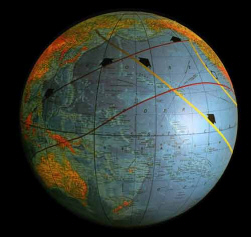
Soviet and U.S. missiles and bombers were designed
to attack each other over the North pole. That was the shortest
route
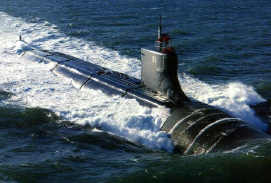 | | |
|
|
|
12.
|
The policy of Deterrence was
designed to prevent a war
a. | but accidents were
possible | d. | all of these
statements are true | b. | and it has been a success | e. | none of these statements are true | c. | and caused a generation of people to live in
fear |
|
|
|
13.
|
Civil defense refers to the
actions that the civilian population can take to protect against nuclear attack. Which statement
below is true about civil defense?
a. | Most people took civil defense
seriously | c. | The U.S. and
Soviets had no civil defense procedures at all | b. | Most people thought civil defense could not protect
them | d. | Civil defense was our first line of defense against
nuclear attack |
|
|
|
14.
|
What was the shortest route for
Soviet and U.S. missiles and bombers to attack each other.
a. | Over the North
Pole | c. | Across the Pacific
Ocean | b. | Across the Atlantic Ocean | d. | Through Normandy as was done in
WWII |
|
|
|
ANTI-MISSILES
The Soviet military was unconvinced by the MAD theory. They worked to develop
anti-ballistic missiles -- ABMs -- that could destroy U.S. missiles in flight. The introduction of
ABMs destabilized the concept of MAD. Tensions in the Middle East, brought on by the 1967 Six Day
War, prompted U.S. President Johnson and Soviet Premier Kosygin to meet for a summit. The issue of
ABMs was high on their agenda.
U.S. scientists, meanwhile, prepared a counter-measure: Multiple
Independently Targeted Re-Entry Vehicles -- MIRVs for short. One single missile could now carry 10
separate warheads, each capable of destroying a city.
Nixon the Peacemaker
By 1969, the superpowers were, between them, spending more than $50 million a
day on nuclear armaments. It was a burden both sides found intolerable, and it led to negotiations
known as SALT, the Strategic Arms Limitation Talks. SALT dragged on until 1972, when U.S. President
Nixon went to Moscow to sign the arms agreements with Soviet Premier Brezhnev. ABMs had now been
discredited, but the two sides could not come to a lasting agreement on offensive nuclear weapons.
Preparations for global annihilation continued.
| 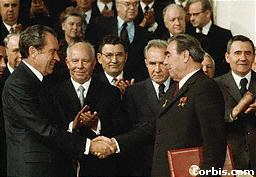
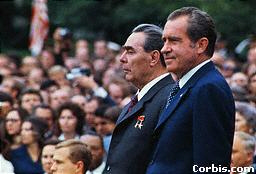
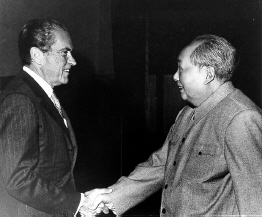 | | |
|
|
|
15.
|
How did the Soviets try to
counteract the MAD theory
a. | By banning all nuclear
weapons | c. | By developing
ABMs | b. | By deploying MIRVs | d. | By appealing to the U.N. |
|
|
|
16.
|
Which missiles were designed to
carry 10 nuclear warheads that would spread out and destroy 10 cities instead of 1 when it came close
to its target?
a. | AbMs | c. | B1s | b. | MIRVs | d. | Stealth War Heads |
|
|
|
17.
|
Why were the Soviets and the
U.S. concerned about the Six Day War between Israel and it’s Arab
neighbors?
a. | Almost everything that happened
throughout the world was part of the cold war | c. | All of these a valid sources of concern for the Soviets and the
U.S. | b. | The U.S. was backing Israel while the Soviets were backing the Arab
states | d. | They were afraid that conflict in the Middle East could
cause a confrontation between the West and the Soviets |
|
|
|
18.
|
The SALT treaty
a. | successfully limited offensive
weapons between the Americans and Soviets | c. | was not agreed to be the Soviets | b. | was only partially successful but it was a
start | d. | was not agreed to by the
U.S, |
|
|
|
19.
|
Who signed the SALT treaty for
the U.S,?
a. | Truman | c. | Kennedy | b. | Johnson | d. | Nixon |
|
|
|
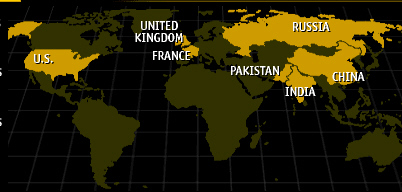 |
The Nuclear Club
Nations in the world that have nuclear
weapons | | |
|
|
|
20.
|
Which country below does
not have nuclear weapons
today?
a. | India | c. | China | b. | Pakistan | d. | Syria |
|